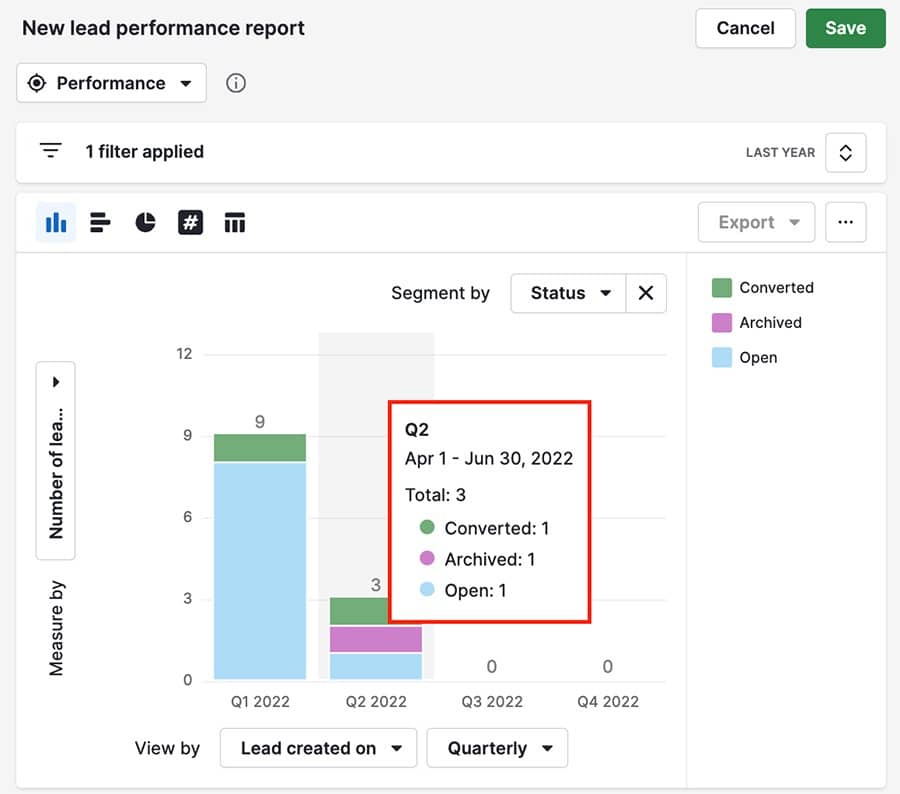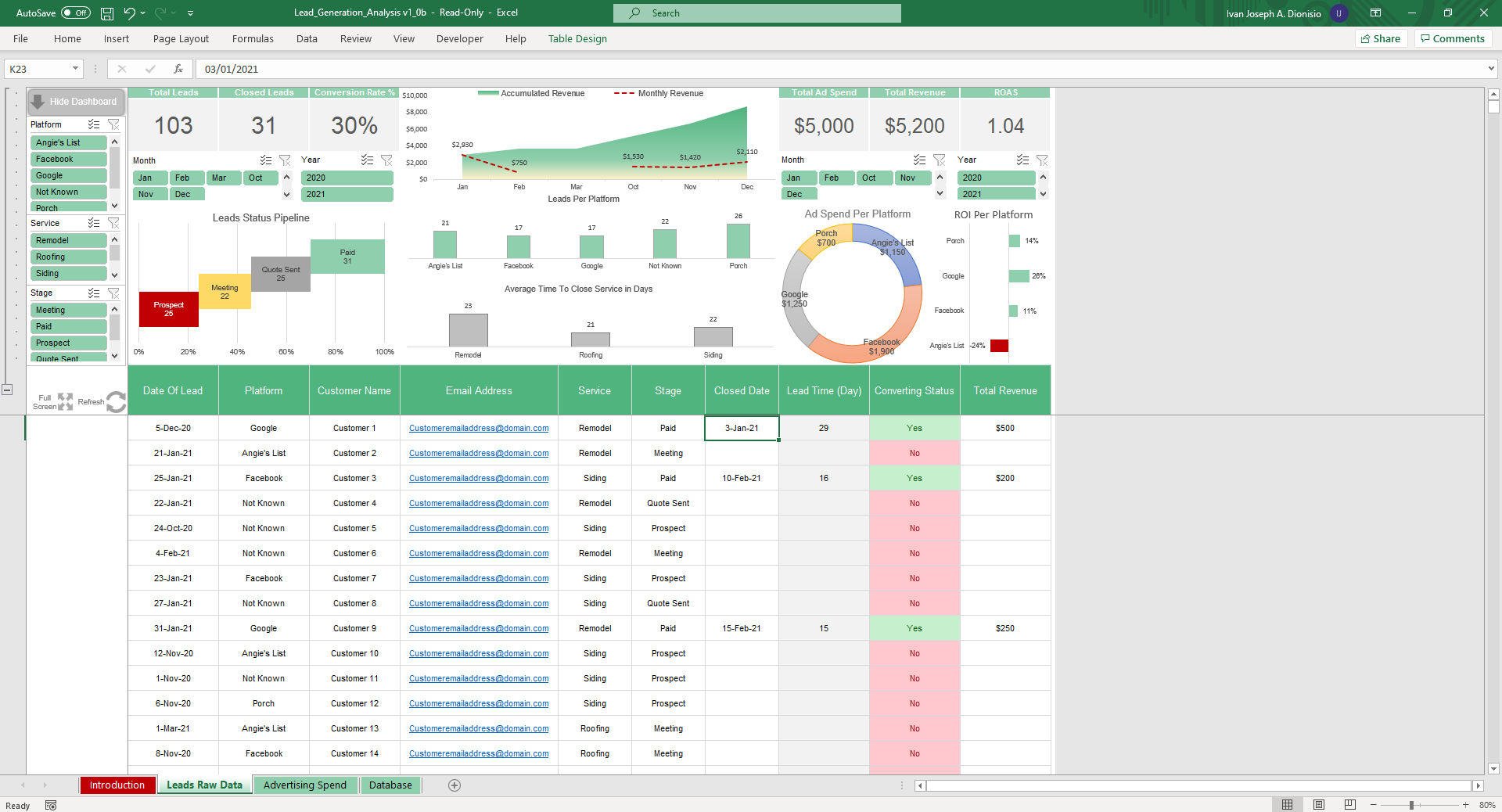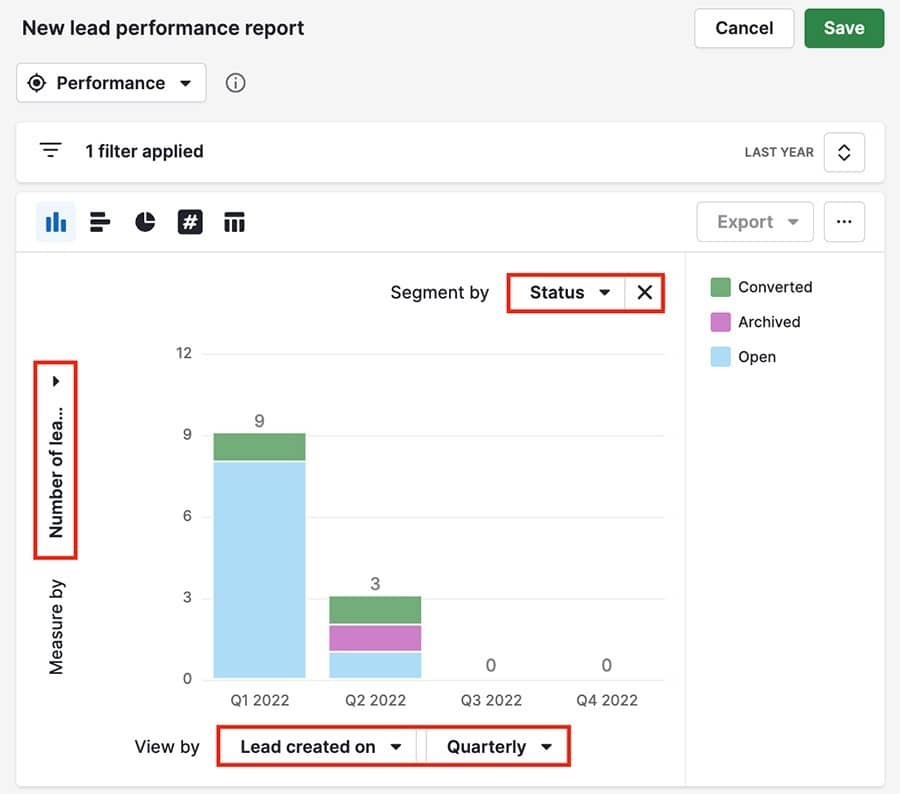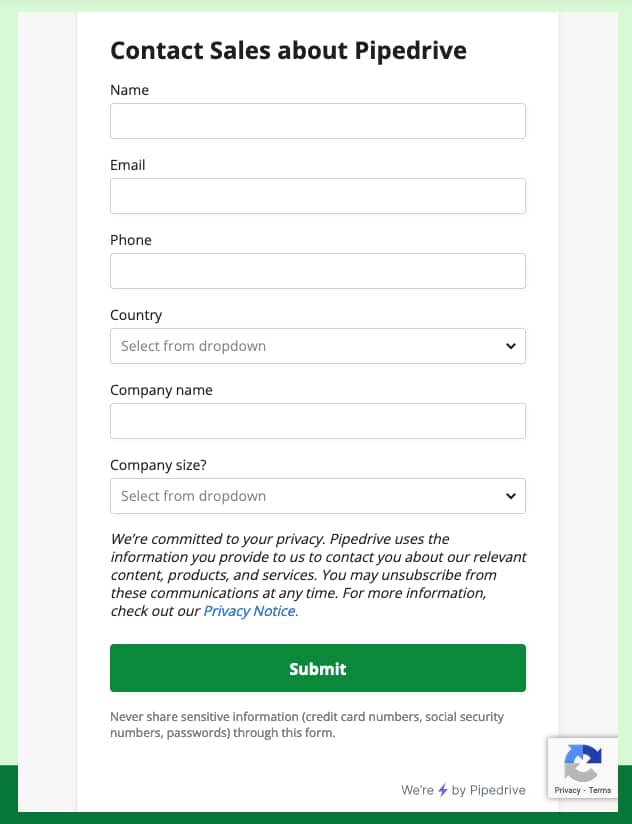Our view at Stack - Pipedrive is a robust CRM platform, offering automation, contact data collection, webhooks, AI-powered sales assistant, email communications, email marketing, and customisable sales pipeline workflows.
Leads reporting is the best way to see how effectively your team finds and wins new business.
Whether you use spreadsheets or sales software, reporting turns raw data into actionable insights that can help you make better decisions throughout the customer journey.
In this article, you’ll learn what lead reporting involves, which metrics are most helpful and how to get started with or without a customer relationship management (CRM) tool.
What is leads reporting?
Lead reporting is the process of analyzing how potential customers (i.e., leads) enter and move through your sales cycle. It involves measuring lead generation, management and conversion efforts to determine the effectiveness of your overall sales process.
More specifically, leads reporting helps companies understand where their leads come from, how those leads engage with the business and which strategies generate sales most effectively.
You can create reports manually with a simple spreadsheet or generate them automatically through CRM software.
For instance, here’s what a leads report looks like in Pipedrive.

What you learn will depend on the data you collect. All businesses have their priorities, but some of the most valuable leads reporting metrics are:
-
Leads created. The total number of leads generated in a given period.
-
Leads qualified. The number of leads that meet your criteria for potential customers.
-
Leads archived. The number of leads that drop out of the sales pipeline due to lack of interest or qualification.
-
Conversion rate. The percentage of leads that become paying customers.
-
Time taken to convert leads into customers. The average duration from lead creation to conversion.
-
Lead source. Where leads come from (e.g., social media, email campaigns or cold calling).
You might include these metrics in your first report and then refine your selection as you learn what data is most useful to your company.
Recommended reading

How to Stop Losing Your Best Leads Because of Missed Follow Ups
Why is lead reporting beneficial?
Effective leads reporting allows you to make more informed decisions on which types of people to target and how to engage them.
Over time, it’ll improve your customer understanding to help you deliver personalized experiences that make sales more likely.
Here are the benefits of leads reporting in more detail.
It keeps your sales cycle moving
Leads reporting helps maintain momentum in the sales cycle by providing insights into the overall flow of buyers through the funnel.
By monitoring lead performance across all stages, businesses can find and fix bottlenecks, ensuring prospects are more likely to move toward conversion than drop out.
For example, if qualified leads keep stalling at your sales demo stage, you might revisit your demonstration approach and provide more presentation training for the sales team.
Four Steps to Finding the Right Leads Fast
Make instant improvements to your lead qualification process with this four-step guide full of actionable sales advice.
It tells you if your marketing works
Lead reporting helps identify which marketing channels generate the most leads. Using that information, you can allocate marketing resources for maximum impact.
For example, suppose you create a report containing “new leads generated” metrics for social media advertising and email marketing. In that case, you’ll know which delivers the best return and where to direct your spending in the future.
If your report shows that a new campaign isn’t performing well, you can make tweaks to improve its effectiveness. The continuous feedback loop allows you to generate high-quality leads and grow your business.
It helps you refine your sales strategy
Lead generation data gives you insights into your marketing performance. Management and conversion data show how well your sales strategy works.
Let’s say your “number of leads created” and “leads qualified” metrics are on target most months, but conversions are falling. It could show that:
The sooner you know an issue exists (i.e., with help from regular leads reporting), the sooner you can investigate and address it.
Recommended reading

How to set marketing OKRs and 10 examples
How to create insightful leads reports in 6 simple steps
Lead reporting is simple to carry out for such a beneficial activity.
Recording lead data in a spreadsheet is the cheapest way to generate insightful leads reports and is suitable for some small businesses and freelancers. However, manual reporting processes get increasingly complex as your company and data pool grow.
A much easier way is to use an intuitive CRM tool. It’ll give you instant access to up-to-date lead data from various sources, including website forms, social media platforms and email marketing campaigns.
Whichever tool you choose, you can use the following steps to create your first leads report.
1. Pinpoint the lead information you want to track
First, determine what lead information is most valuable to your business, as this will shape your reports.
The four core metrics (leads created, qualified, archived and converted) give a broad view of lead performance, but what else will help you better understand your leads’ journeys?
Other metrics to consider include:
-
Leads generated by source to learn which of your lead-gen tactics is most effective
-
Leads archived by funnel stage to learn where prospects fall out of the funnel
-
Average time to conversion to learn how efficient your sales cycle is
By pinpointing the most valuable information, you’ll ensure your lead reports always deliver insights that you can use to help your business.
2. Choose your lead reporting system
There are two main types of tools you can use for lead reporting: spreadsheets and CRM software.
Both options have advantages, although CRM software speeds up the process by organizing sales and customer data and automating basic admin.
For example, generating a report in Pipedrive is as simple as navigating to the lead performance page and customizing your parameters to show relevant data (e.g., period, status and metric).
Pipedrive has pricing plans to suit most budgets, or you can create a lead reporting spreadsheet for free using Excel or Google Sheets.
Remember that you’ll need to manually configure your spreadsheet to show your chosen metrics and update the data field by field to generate new reports.
Note: You can import lead data from Excel and Google Sheets files straight into Pipedrive, making it quick and easy to upgrade when the time is right.
3. Customize your reports (based on your KPIs)
Whether you use a spreadsheet or CRM system to store lead data will determine how long it takes to customize your reports.
Customizing reports in a spreadsheet involves manually inputting fields and data, setting up formulas and designing charts. You must ensure data is consistently updated and formatted to maintain accuracy.
For example, you can use functions and pivot tables in Excel and Google Sheets to summarize and analyze your sales data. You may also share your files with colleagues and other teams via email.
Here’s an example of what the result might look like using a template from Simple Sheets.

Alternatively, a good CRM will allow you to customize metrics, timeframes and other details using simple menus and then source the relevant data automatically.
In Pipedrive, you just need to adjust the options highlighted in the example image below.

Once you’ve made your customizations, you’ll see the data you find most helpful for improving your sales and marketing strategies.
4. Optimize your lead capture process
Refine your lead-generation process to ensure you’re collecting the same valuable information across various channels. Otherwise, you risk building an incomplete picture of your leads and ultimately generating inaccurate reports.
For example, standardizing the fields in lead capture forms on your website, social media and landing pages ensures you collect the same type of information from every lead and have everything you need to assess them properly. It results in a smoother qualification process and, eventually, more sales.
Keep your information requests simple to avoid overwhelming potential customers. You can always ask for more details in a follow-up email or call.
Here’s an example of a simple web form from Pipedrive’s contact page.

Integrating your lead capture forms (and other lead-generation campaigns) with your CRM system allows seamless data transfer. It ensures all lead information is centralized, standardized and easy for your sales and marketing teams to access.
Part of Pipedrive’s LeadBooster add-on, Web Forms streamlines the entire lead-generation process by synchronizing new contacts’ data. Once a customer completes one of your forms, their data is automatically added to your CRM’s database and ready to report.
Start generating quality leads with your B2B Prospecting ebook
This guide will help you find high-quality leads while staying compliant with the rules and regulations.
5. Map out and audit your lead data
Data hygiene is an ongoing process that ensures your reports are always accurate and helpful. By practicing it before you create your first report, you’ll ensure you get useful insights from day one. It’ll save you wasting time and resources.
A simple data audit will help you get everything in order. You can use the following as a checklist for your first one:
-
Remove duplicate entries. Removing duplicates ensures each lead record is unique and prevents misleading reports.
-
Update outdated information. Data that reflects the actual current status of each lead will contribute to timely reports for better decision-making (e.g., if a prospect dropped out of the pipeline but is interested again, update their lead status accordingly).
-
Segment leads based on current data. Segmenting leads (splitting them into groups with common characteristics) allows for more detailed reporting on different lead categories.
Do all this monthly or quarterly to keep your data clean and valuable.
If you use a spreadsheet, you must clean your data manually. This process involves reviewing your data line by line, identifying duplicates and fixing inaccuracies. It’s a time-consuming activity, especially if you have lots of lead data to work with.
Using a CRM simplifies the process, saving valuable time. For example, Pipedrive offers a “merge duplicates” feature that automatically identifies and merges duplicate entries.
With your reporting tool in place and your data audited, you can start generating reports. Creating reports monthly or quarterly allows you to compare performance.
Note: Although it won’t impact your reporting, it’s also worth verifying leads’ contact details regularly so that outdated phone numbers and email addresses don’t hurt your outreach efforts.
6. Analyze your results and adjust your strategy accordingly
Use your lead reports to identify trends and improvement opportunities. Then, you can refine your lead generation, nurturing and conversion strategies to close more deals and make your business more successful.
For example, you might notice that some lead sources consistently generate higher quality leads than others or that lead activity increases in certain date ranges. Knowing this would allow you to spend your marketing dollars more effectively.
In contrast, a dip in lead activity after you update your marketing strategy is a sign to reassess your changes – or wait until the following report if you’ve switched from a short-term tactic (e.g., social media advertising) to a longer-term one (e.g., search engine optimization, or SEO).
Recommended reading
How to track your email campaigns with Google Analytics email tracking
Leads reporting FAQs
Final thoughts
Knowing how to create a lead report equips you to make better business decisions, build effective marketing campaigns and close more deals.
However, lead reporting isn’t a one-time thing. Make it a regular part of managing your business or sales team to ensure you generate plenty of helpful insights for your growth strategy.
If using a spreadsheet, turn your first report into a template for adding the latest lead data every month or quarter. If you’re using a CRM, you can automate the process to free time for other sales tasks.
If Pipedrive is of interest and you'd like more information, please do make contact or take a look in more detail here.
Credit: Original article published here.
